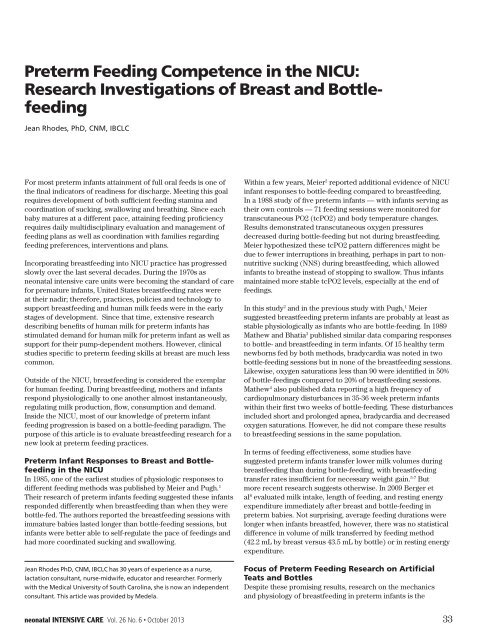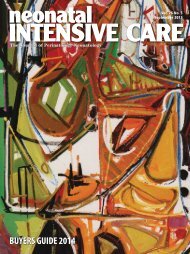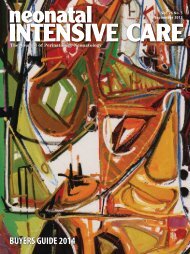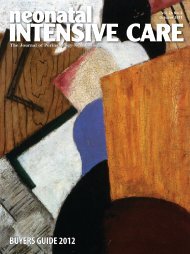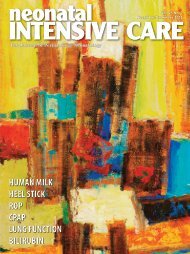Create successful ePaper yourself
Turn your PDF publications into a flip-book with our unique Google optimized e-Paper software.
Preterm Feeding Competence in the NICU:Research Investigations of Breast and BottlefeedingJean Rhodes, PhD, CNM, IBCLCFor most preterm infants attainment of full oral feeds is one ofthe final indi<strong>ca</strong>tors of readiness for discharge. Meeting this goalrequires development of both sufficient feeding stamina andcoordination of sucking, swallowing and breathing. Since eachbaby matures at a different pace, attaining feeding proficiencyrequires daily multidisciplinary evaluation and management offeeding plans as well as coordination with families regardingfeeding preferences, interventions and plans.Incorporating breastfeeding into NICU practice has progressedslowly over the last several de<strong>ca</strong>des. During the 1970s asneonatal intensive <strong>ca</strong>re units were becoming the standard of <strong>ca</strong>refor premature infants, United States breastfeeding rates wereat their nadir; therefore, practices, policies and technology tosupport breastfeeding and human milk feeds were in the earlystages of development. Since that time, extensive researchdescribing benefits of human milk for preterm infants hasstimulated demand for human milk for preterm infant as well assupport for their pump-dependent mothers. However, clini<strong>ca</strong>lstudies specific to preterm feeding skills at breast are much lesscommon.Outside of the NICU, breastfeeding is considered the exemplarfor human feeding. During breastfeeding, mothers and infantsrespond physiologi<strong>ca</strong>lly to one another almost instantaneously,regulating milk production, flow, consumption and demand.Inside the NICU, most of our knowledge of preterm infantfeeding progression is based on a bottle-feeding paradigm. Thepurpose of this article is to evaluate breastfeeding research for anew look at preterm feeding practices.Preterm Infant Responses to Breast and Bottlefeedingin the NICUIn 1985, one of the earliest studies of physiologic responses todifferent feeding methods was published by Meier and Pugh. 1Their research of preterm infants feeding suggested these infantsresponded differently when breastfeeding than when they werebottle-fed. The authors reported the breastfeeding sessions withimmature babies lasted longer than bottle-feeding sessions, butinfants were better able to self-regulate the pace of feedings andhad more coordinated sucking and swallowing.Jean Rhodes PhD, CNM, IBCLC has 30 years of experience as a nurse,lactation consultant, nurse-midwife, edu<strong>ca</strong>tor and researcher. Formerlywith the Medi<strong>ca</strong>l University of South Carolina, she is now an independentconsultant. This article was provided by Medela.Within a few years, Meier 2 reported additional evidence of NICUinfant responses to bottle-feeding compared to breastfeeding.In a 1988 study of five preterm infants — with infants serving astheir own controls — 71 feeding sessions were monitored fortranscutaneous PO2 (tcPO2) and body temperature changes.Results demonstrated transcutaneous oxygen pressuresdecreased during bottle-feeding but not during breastfeeding.Meier hypothesized these tcPO2 pattern differences might bedue to fewer interruptions in breathing, perhaps in part to nonnutritivesucking (NNS) during breastfeeding, which allowedinfants to breathe instead of stopping to swallow. Thus infantsmaintained more stable tcPO2 levels, especially at the end offeedings.In this study 2 and in the previous study with Pugh, 1 Meiersuggested breastfeeding preterm infants are probably at least asstable physiologi<strong>ca</strong>lly as infants who are bottle-feeding. In 1989Mathew and Bhatia 3 published similar data comparing responsesto bottle- and breastfeeding in term infants. Of 15 healthy termnewborns fed by both methods, brady<strong>ca</strong>rdia was noted in twobottle-feeding sessions but in none of the breastfeeding sessions.Likewise, oxygen saturations less than 90 were identified in 50%of bottle-feedings compared to 20% of breastfeeding sessions.Mathew 4 also published data reporting a high frequency of<strong>ca</strong>rdiopulmonary disturbances in 35-36 week preterm infantswithin their first two weeks of bottle-feeding. These disturbancesincluded short and prolonged apnea, brady<strong>ca</strong>rdia and decreasedoxygen saturations. However, he did not compare these resultsto breastfeeding sessions in the same population.In terms of feeding effectiveness, some studies havesuggested preterm infants transfer lower milk volumes duringbreastfeeding than during bottle-feeding, with breastfeedingtransfer rates insufficient for necessary weight gain. 5-7 Butmore recent research suggests otherwise. In 2009 Berger etal 8 evaluated milk intake, length of feeding, and resting energyexpenditure immediately after breast and bottle-feeding inpreterm babies. Not surprising, average feeding durations werelonger when infants breastfed, however, there was no statisti<strong>ca</strong>ldifference in volume of milk transferred by feeding method(42.2 mL by breast versus 43.5 mL by bottle) or in resting energyexpenditure.Focus of Preterm Feeding Research on ArtificialTeats and BottlesDespite these promising results, research on the mechanicsand physiology of breastfeeding in preterm infants is theneonatal INTENSIVE CARE Vol. 26 No. 6 • <strong>October</strong> <strong>2013</strong> 33


